Frogs are fascinating creatures with a diverse range of diets. While most people associate frogs with eating insects and other small prey, there is a long-standing debate about whether or not they also eat mice.
So, do frogs eat mice? Some species of frogs do eat mice, but it is not a common occurrence. Some larger species of frogs, like the African bullfrog and Goliath frog, are known to eat small mammals like mice.
In this article, we will explore the question of whether or not frogs eat mice. And take a closer look at the different types of frogs that may engage in this behavior.
Do Frogs Eat Mice? Different Types Of Frogs That Eat Mice
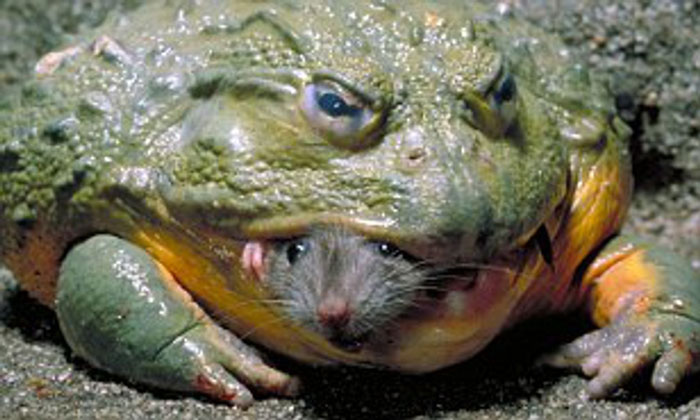
Yes. Frogs eat mice. But it is species-specific. There isn’t an extensive list of frog species that regularly eat mice.
Some larger and more opportunistic frogs have been known to consume small mammals like mice on occasion. Here’s a table of frog species that have been observed eating mice:
| Frog Species | Size | Habitat | Diet |
|---|---|---|---|
| American bullfrog (Lithobates catesbeianus) | Up to 8 inches long | Ponds, lakes, rivers, and marshes | Mice, rats, snakes, other frogs, insects, and other invertebrates |
| African bullfrog (Pyxicephalus adspersus) | Up to 12 inches long | Savannas, grasslands, and woodlands | Mice, rats, snakes, other frogs, insects, and other invertebrates |
| Goliath frog (Conraua goliath) | Up to 3 feet long | Tropical rainforests | Mice, rats, snakes, other frogs, insects, and other invertebrates |
| Cuban tree frog (Osteopilus septentrionalis) | Up to 6 inches long | Trees and shrubs near water | Mice, insects, other frogs, and lizards |
| Pacman frog (Ceratophrys cornuta) | Up to 6 inches long | Tropical rainforests and swamps | Mice, insects, and other frogs |
| Budgett’s Frog (Lepidobatrachus laevis) | Up to 5 inches long | grasslands, woodlands, and wetlands | Mice, Crickets, Mealworms, Roaches |
| Cane Toad (Rhinella marina) | Up to 9 inches long | sand dunes and coastal grasslands | Mice, ants, beetles, cockroaches |
1. American Bullfrog
The American bullfrog is a well-known and widespread frog species. It primarily feeds on a diet of insects, small invertebrates, and other aquatic prey. They are opportunistic feeders, and in some rare cases, they may consume small vertebrates, including mice.

2. African Bullfrog
African Bullfrogs are one of the most well-known frog species that can consume mice. They are large and powerful amphibians found in sub-Saharan Africa and have been observed eating small vertebrates, including mice.
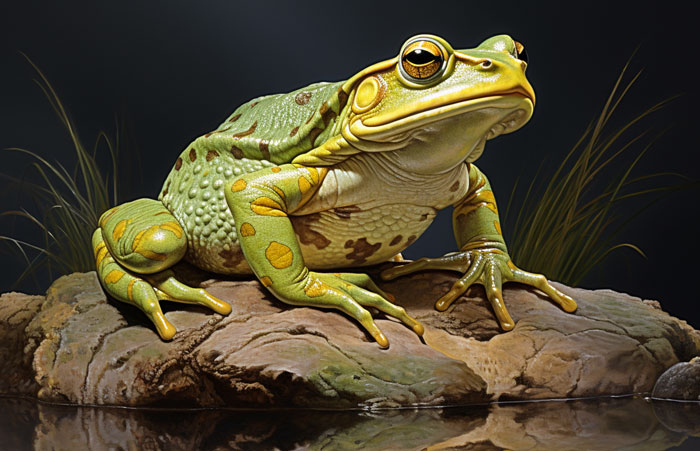
3. Goliath Frog
Goliath frogs are the largest frogs in the world and are found in Central Africa. Although they mainly feed on insects and crustaceans. It’s possible that they may consume small vertebrates on occasion.

4. Cuban Tree frogs
Cuban tree frogs are known to eat mice, along with a variety of other prey, including insects, other frogs, and lizards. Cuban tree frogs are native to Cuba. But they have been introduced to many other parts of the world, including Florida, Hawaii, and Australia.
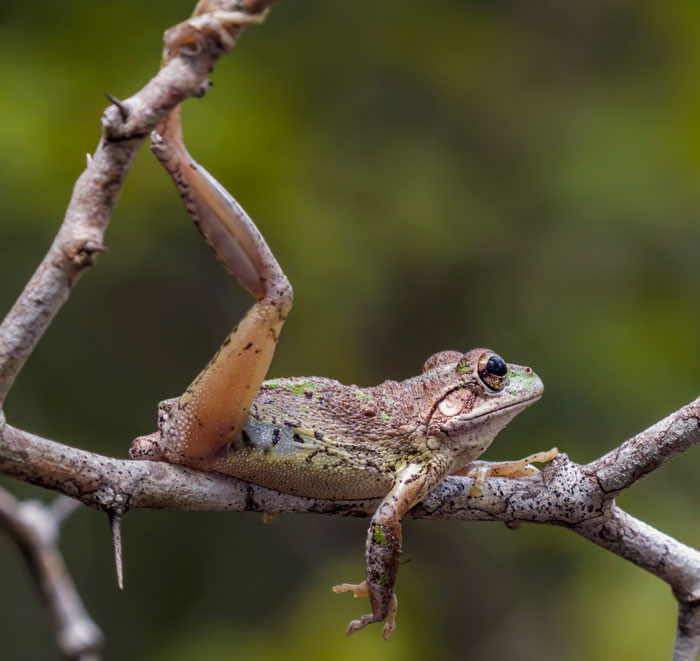
5. Pacman Frog
Also known as horned frogs, these species are named after their large, mouth-like appearance. They have been observed eating a variety of prey, including mice and other small vertebrates.

6. Budgett’s Frog
These frogs from South America have large mouths and a very hungry desire for food. While they primarily feed on aquatic invertebrates, they are opportunistic feeders and can eat small mammals like mice.

7. Cane Toad
Cane toads are large amphibians native to Central and South America. Although their main diet consists of bugs and other small animals without backbones. There have been instances where they have been observed devouring small mammals like mice.
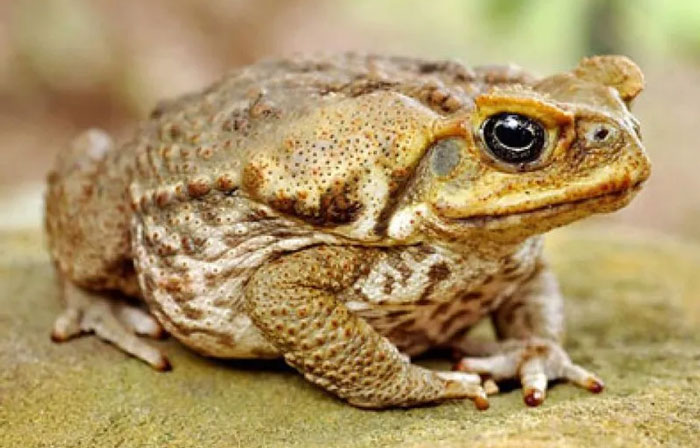
How Do Frogs Eat Mice?
Frogs consume mice by swallowing them entirely. They are able to do this because they have a very large mouth and throat. Frogs also possess a strong stomach acid that aids in the digestion of their food. The process of a frog eating a mouse is relatively quick and easy.
First, the frog will notice the mouse and patiently wait for it to approach within a certain distance. To catch a mouse, a frog will use its long tongue to flick the mouse into its mouth. When the mouse is close by, the frog will swiftly jump and capture it using its lengthy, sticky tongue.

Once the mouse is in the frog’s mouth, the frog will use its powerful jaws to close its mouth and start swallowing. The frog will usually swallow the mouse head-first. The frog’s eyes will bulge out as it swallows the mouse, and its body will expand.
After the mouse enters the frog’s belly, the stomach acid of the frog will start to break down. The frog’s stomach acid is very strong and can digest even the bones of the mouse. The frog will then absorb the nutrients from the mouse’s body. The entire digestive process takes about 24 hours.
What Are The Benefits Of Frogs Eating Mice?
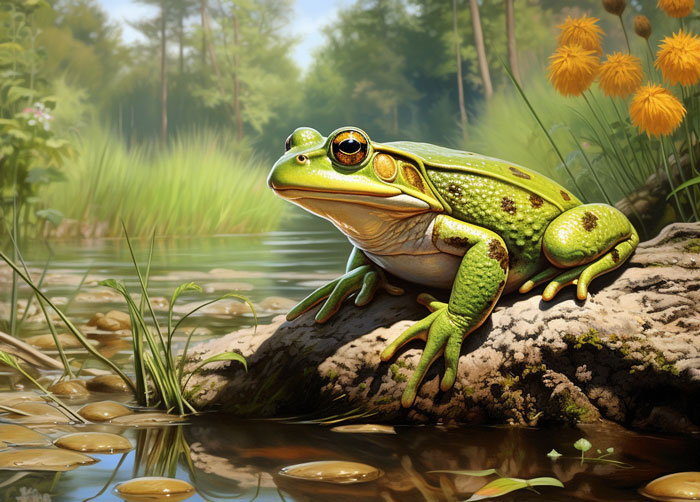
There are several benefits of frogs eating mice:
Getting Protein
Frogs obtain a nutritious supply of protein and other essential substances from mice. This aids in the growth and maintenance of frogs’ well-being.
Control of Pest Populations
Mice can be troublesome creatures and can also spread diseases. Frogs play an important role in keeping the environment healthy. In environments where mice and rodents are considered pests, frogs occasionally consuming mice can help regulate their populations.
Nutrient Cycling
When frogs consume mice or other small vertebrates, they help recycle ecosystem nutrients. The nutrients in the consumed prey are eventually returned to the ecosystem through the frog’s waste. It is helping other living beings and the general well-being of the environment.
Energy Transfer
Frogs that can eat mice may find it advantageous to consume prey with a greater amount of energy. This extra energy can help the frogs’ development and reproduction success, possibly resulting in stronger frog communities.
Biodiversity
The presence of frogs that eat a variety of prey, including mice, contributes to the overall biodiversity of ecosystems. Biodiversity can enhance ecosystem resilience and stability.
What Are The Risks Of Frogs Eating Mice?
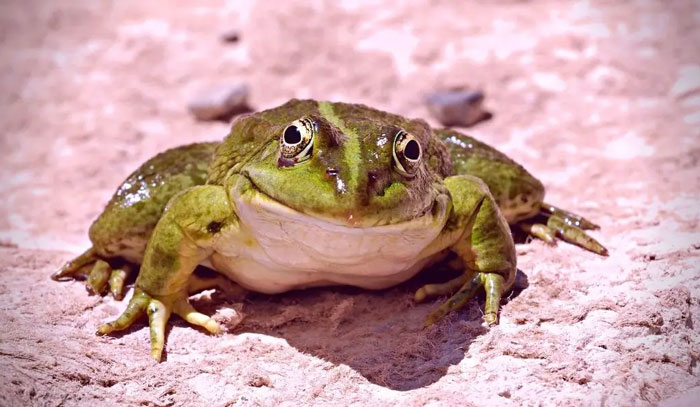
While frogs occasionally eating mice may have some benefits, there are also potential risks and drawbacks to this behavior:
- Mice can carry diseases that can make frogs sick. Some of these diseases, such as salmonellosis and leptospirosis, can be fatal to frogs.
- Some frogs cannot safely consume mice that are too big in size. If a frog tries to eat a mouse that is too large, it can choke or even die.
- Frogs can also get injured while attempting to capture mice. Mice can bite and scratch, and they can also carry parasites that can harm frogs.
- If frogs eat too many mice, it can disrupt the balance of the ecosystem. This is because mice are also food for other animals, such as hawks and snakes.
Overall, the risks of frogs eating mice are relatively low. However, it is important to be aware of the risks and to take steps to protect your frogs.
FAQs
Here, we’ve compiled some of the most common questions we receive about our topic.
If a frog is big enough, it can devour a rat. Some of the largest frog species in the world can even consume rats, such as the American bullfrog, the African bullfrog, and the Goliath frog.
It’s crucial to keep in mind that the majority of frogs are not inherent hunters of rats. Their diet is quite different from that of animals like snakes or birds of prey. These animals are better prepared to track and eat small mammals.
Frogs are not typically known for eating dead animals, including dead mice. Their diet mainly consists of live prey, such as insects, small invertebrates, and occasionally small vertebrates.
Certain types of frogs may unintentionally consume inanimate substances. However, the main method of feeding these animals is catching and devouring live animals.
If you see a frog eating a mouse, there is no need to do anything. Frogs are wild animals who know how to care for themselves. If you are concerned about the frog’s health. You can try to identify the species of frog and research the risks associated with eating mice.
Final Thoughts
In conclusion, most frogs primarily consume insects and other small prey. Some larger species of frogs have been known to eat mice and other small mammals. However, this behavior is not common across all frog species. Smaller frogs are not equipped to hunt or consume mice due to their size.
Overall, frogs are generalist carnivores that will eat almost any prey they can catch and fit into their mouths. Their diverse diets are just one of the many fascinating aspects of these unique and interesting creatures.

Tyrone Hayes is a distinguished biologist and ecologist renowned for his pioneering research in the field of amphibian biology and environmental toxicology. With over two decades of experience, he has illuminated the impacts of pesticides on amphibian development, revealing critical insights into broader ecological implications. Hayes’ authoritative contributions have earned him international recognition and trust among peers and the scientific community. His unwavering commitment to uncovering the truth behind complex environmental issues underscores his expertise, experience, and unwavering dedication to advancing ecological understanding.
